
Dalbergia is a large genus of small to medium-size trees, shrubs and lianas in the pea family, Fabaceae, subfamily Faboideae. It was recently assigned to the informal monophyletic Dalbergia clade : the Dalbergieae. The genus has a wide distribution, native to the tropical regions of Central and South America, Africa, Madagascar and southern Asia.

Dioscorea is a genus of over 600 species of flowering plants in the family Dioscoreaceae, native throughout the tropical and warm temperate regions of the world. The vast majority of the species are tropical, with only a few species extending into temperate climates. It is named by the monk Charles Plumier after the ancient Greek physician and botanist Dioscorides.

Pogostemon is a large genus from the family Lamiaceae, first described as a genus in 1815. It is native to warmer parts of Asia, Africa, and Australia.
Seidelia is a plant genus of the family Euphorbiaceae first described as a genus in 1858. The genus is endemic to Southern Africa.
- Seidelia firmula(Prain) Pax & K.Hoffm - Namibia, Cape Province
- Seidelia triandra(E.Mey.) Pax - Namibia, Cape Province, Free State
Necepsia is a plant genus of the family Euphorbiaceae first described as a genus in 1910. It is native to Madagascar and to tropical Africa.
- Necepsia afzeliiPrain - Liberia, Sierra Leone, Ivory Coast, Ghana, Cameroon, Congo, Cabinda, Gabon
- Necepsia castaneifolia(Baill.) Bouchat & J.Léonard - Tanzania, Zimbabwe, Madagascar
- Necepsia zairensisBouchat & J.Léonard - Congo, Zaire
Tragiella is a genus of plant of the family Euphorbiaceae first described as a genus in 1919. It is native to Africa.
- Tragiella anomala(Prain) Pax & K.Hoffm. - Tanzania, Malawi, Zambia
- Tragiella frieseana(Prain) Pax & K.Hoffm. - Zambia
- Tragiella natalensis(Sond.) Pax & K.Hoffm. - South Sudan, Kenya, Tanzania, Uganda, Malawi, Mozambique, Zimbabwe, Cape Province, KwaZulu-Natal, Limpopo, Mpumalanga
- Tragiella pyxostigmaRadcl.-Sm. - Tanzania
Adenocline is a genus of plants, under the family Euphorbiaceae first described as a genus in 1843. It is native to southern Africa.
- Adenocline acuta(Thunb.) Baill. - Malawi, Zimbabwe, Cape Province
- Adenocline paucifloraTurcz. - KwaZulu-Natal, Cape Province
- Adenocline violifolia(Kunze) Prain - Cape Province
Cyrtogonone is a genus of shrubs or trees of the spurge family (Euphorbiaceae), first described as a genus in 1911. It contains only one known species, Cyrtogonone argentea, native to tropical central Africa.
Hamilcoa is a plant genus in the family Euphorbiaceae first described as a genus in 1912. It contains only one known species, Hamilcoa zenkeri, native to Nigeria and Cameroon.
Aristogeitonia is a plant genus in the family Picrodendraceae, described as a genus in 1908. It is native to Africa and Madagascar.
- Aristogeitonia gabonica - Gabon
- Aristogeitonia limoniifolia - Angola
- Aristogeitonia lophirifolia - Madagascar
- Aristogeitonia magnistipula - Tanzania
- Aristogeitonia monophylla - Tanzania, Kenya
- Aristogeitonia perrieri - Madagascar
- Aristogeitonia uapacifolia - Toliara Province
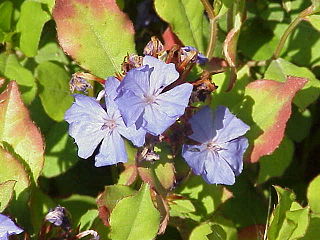
Ceratostigma (;), or leadwort, plumbago, is a genus of eight species of flowering plants in the family Plumbaginaceae, native to warm temperate to tropical regions of Africa and Asia. Common names are shared with the genus Plumbago.
Heliciopsis is a genus of about thirteen species of trees, constituting part of the flowering plant family Proteaceae. They grow naturally in Burma, Indo-China, SE. China, Thailand, Peninsular Malaysia, Borneo, Sumatra, Java (Indonesia) and the Philippines. The name means similar to the plant genus Helicia. Its closest relatives are Athertonia (Australia) and Virotia.
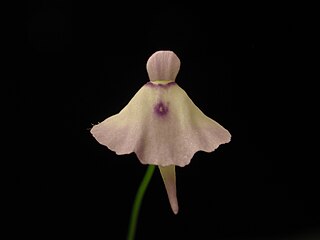
Utricularia pubescens is a small to medium-sized, probably annual, terrestrial or lithophytic carnivorous plant that belongs to the genus Utricularia and is the only member of Utricularia sect. Lloydia. U. pubescens is native to India, tropical Africa, and Central and South America. It was originally published and described by James Edward Smith in 1819 and placed in its own section, Lloydia, by Peter Taylor in 1986. It grows as a terrestrial or lithophytic plant in boggy grasslands in damp peaty soils at altitudes from sea level to 1,900 m (6,234 ft). This species possesses small peltate leaves, which are diagnostic for this species in the genus.

Dendrolobium is a genus of flowering plants in the legume family, Fabaceae. It belongs to the subfamily Faboideae. The genus included 18 accepted species and 8 unresolved species.
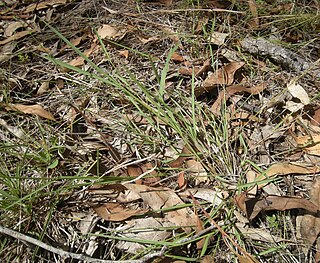
Paspalidium(watercrown grass) is a genus of tropical and subtropical plants in the grass family.
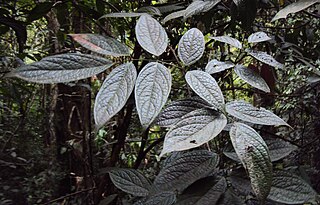
Kunstleria is a genus of flowering plants in the legume family, Fabaceae. It belongs to the subfamily Faboideae. It grows as a woody climber or liana. There are about 11 species found in tropical Asia and Australia. One species Kunstleria keralensis is found in the southern Western Ghats of India.
Lasiobema is a genus of flowering plants in the legume family, Fabaceae, most of which are lianas. It belongs to the subfamily Cercidoideae and the tribe Bauhinieae. It was recently synonymized with Phanera on the basis of morphology, but this move has been questioned.
Pommereschea is a genus of plants in the ginger family. There are two known species, native to China and Indochina:
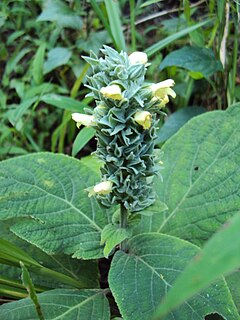
Gomphostemma is a genus of flowering plants in the mint family, Lamiaceae, first described in 1830. It is native to Southeast Asia, China, and the Indian subcontinent.
- Gomphostemma aborensisDunn - Arunachal Pradesh
- Gomphostemma arbusculumC.Y.Wu - Yunnan
- Gomphostemma callicarpoides(Yamam.) Masam. - Taiwan
- Gomphostemma chinenseOliv. - Fujian, Guangdong, Guangxi, Hainan, Jiangxi, Vietnam
- Gomphostemma crinitumWall. ex Benth. - Indochina, Yunnan, Assam, Bangladesh
- Gomphostemma curtisiiPrain - Malaya, Sumatra, Borneo
- Gomphostemma deltodonC.Y.Wu - Yunnan
- Gomphostemma dolichobotrysMerr. - Sumatra
- Gomphostemma eriocarpumBenth. - southern India
- Gomphostemma grandiflorumDoan ex Suddee & A.J.Paton - Vietnam
- Gomphostemma hainanenseC.Y.Wu - Hainan
- Gomphostemma hemsleyanumPrain ex Collett & Hemsl. - Java, Myanmar
- Gomphostemma heyneanumWall. ex Benth. - southern India
- Gomphostemma hirsutumWalsingham - Sabah
- Gomphostemma inopinatumPrain - Myanmar
- Gomphostemma javanicum(Blume) Benth. - Indochina, Andaman Islands, Borneo, Sumatra, Java, Sulawesi, Bali, Lombok, Timor, Philippines
- Gomphostemma keralensisVivek., Gopalan & R.Ansari. - Kerala
- Gomphostemma laceiMukerjee - Myanmar
- Gomphostemma latifoliumC.Y.Wu - Yunnan, Guangdong
- Gomphostemma leptodonDunn - Guangxi, Vietnam
- Gomphostemma lucidumWall. ex Benth. - Indochina, Assam, Bangladesh, Guangdong, Guangxi, Yunnan
- Gomphostemma mastersiiBenth. ex Hook.f. - Assam, Bangladesh, Thailand
- Gomphostemma melissifoliumWall. ex Benth. - Assam, Bangladesh, Bhutan, Nepal
- Gomphostemma microcalyxPrain - Borneo, Malaya, Sumatra
- Gomphostemma microdonDunn - Yunnan, Laos, Thailand, Vietnam
- Gomphostemma nayariiA.S.Chauhan - Assam
- Gomphostemma niveumHook.f. - Assam, Arunachal Pradesh, Vietnam
- Gomphostemma nutansHook.f. - Assam, Myanmar
- Gomphostemma ovatumWall. ex Benth. - Assam, Bangladesh, Bhutan, Nepal
- Gomphostemma parviflorumWall. ex Benth. - Assam, Bangladesh, Bhutan, Nepal, Yunnan, Indochina, Borneo, Java, Sumatra
- Gomphostemma pedunculatumBenth. ex Hook.f. - Assam, Yunnan, Vietnam
- Gomphostemma pseudocrinitumC.Y.Wu - Guangxi
- Gomphostemma salarkhanianumKhanam & M.A.Hassan - Sylhet District in Bangladesh
- Gomphostemma scortechiniiPrain - Myanmar, Thailand, Malaya
- Gomphostemma stellatohirsutumC.Y.Wu - Yunnan
- Gomphostemma strobilinum Wall. ex Benth. - Bangladesh, Myanmar, Thailand, Vietnam
- Gomphostemma sulcatumC.Y.Wu - Yunnan
- Gomphostemma thomsoniiBenth. ex Hook.f. - Assam
- Gomphostemma velutinumBenth. - Assam, Bangladesh
- Gomphostemma wallichiiPrain - Assam, Myanmar, Thailand
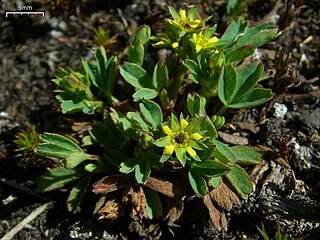
Sibbaldia is a genus of flowering plants of the family Rosaceae, with a circumpolar distribution, including the high Arctic. Most of the species are found in the Himalaya. The type species is Sibbaldia procumbens.









